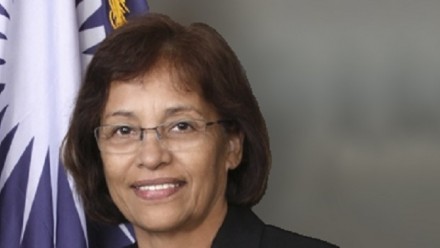ST Lee Lecture - Climate change crisis: an examination of the turbulent history and modern day consequences of the vulnerability of the Marshall Islands
Low elevation, extreme floods and persistent droughts have left the Marshall Islands and its people at the mercy of rising sea levels and under threat of losing their homes.
Join H.E. President Hilda C. Heine as she discusses the threats facing the Marshall Islands, what lessons we can learn from their journey, and what action needs to be taken now.
The Marshall Islands are located in the Central Pacific and made up of 1,156 individual islands and islets that form part of Micronesia. They are home to 53,158 people (as at 2011 Census). The Islands were once occupied by the Japanese until the United States invaded during World War II, turning the islands into a battleground before taking over occupation in 1944.
During the Cold War period, the United States turned the Marshall Islands into a nuclear weapon testing ground, including testing the world’s first hydrogen bomb, the Mike Shot in 1952, which completely destroyed the island of Elugelab in Enewetak Atoll. These tests had devastating effects on the environment and the health of the Marshallese people. Radiation levels from the nuclear fallout make many of the northern islands of the Marshall Islands uninhabitable to this day particularly, Bikini Atoll, where the infamous Bravo shot was detonated in 1954.
Historically, the Marshallese were skilled navigators who used the stars and stick charts to navigate the seas. Today, the locals live predominantly off the service industry as well as the fishing and agriculture industries and are at risk of becoming climate change refugees.
About the speaker
H.E. President Hilda C. Heine was elected in January 2016 and is currently serving as the eighth President of the Republic of the Marshall Islands. President Heine is the first woman to ever hold the presidency of the Marshall Islands, the first female president of any Micronesian country as well as one of only three women in the Marshallese parliament. She is also the first Marshallese citizen to earn a doctorate degree.
Prior to assuming office President Heine served as the Minister of Education from 2012-2015. Previously, President Heine was the Program Director for the Pacific Comprehensive Assistance Centre at the Pacific Resources for Education and Learning (PREL) in Honolulu. Before PREL, President Heine served as the Secretary of Education from 1993-1995, a post she was appointed to following her role as the first President for the College of the Marshall Islands from 1991-1993. President Heine has also been involved with the Pacific Islands Climate Change Education Partnership, the Leadership Pacific Advisory Board, the Commission on Education in Micronesia, and the Human Resources in Health Task Force. She is a climate change and gender issues advocate and the founder of the women's rights group Women United Together Marshall Islands.
President Heine completed her undergraduate studies at the University of Oregon and graduated with a masters degree from the University of Hawaii. She received her doctorate in educational leadership from the University of Southern California. President Heine has co-authored a number of publications and reports amongst them A Marshallese Islands Perspective, Tree of Opportunity: Re-Thinking Pacific Education, Intergenerational Programs and Practice in the Marshall Islands: Implications for Cultural Preservation, and Culturally Responsive Schools for Micronesian Immigrant Students.
About the ST Lee Lecture on Asia and the Pacific
The ST Lee Lecture series was established following an endowment from Dr Seng Tee Lee (ST Lee) of the Lee Foundation in Singapore. It supports an annual lecture that provides the opportunity for a distinguished figure from the Asia Pacific to speak on developments or trends in the region.
Register for the event
Register for this event through Eventbrite:








